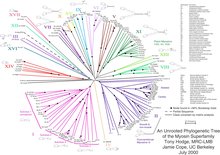Phylogenetic tree
|
|
Missing image PhylogeneticTree.jpg Fig. 1: A rooted tree for rRNA genes |
A phylogenetic tree is a tree showing the evolutionary interrelationships among various species or other entities that are believed to have a common ancestor. A phylogenetic tree is a form of a cladogram. In a phylogenetic tree, each node with descendants represents the most recent common ancestor of the descendants, and edge lengths correspond to time estimates. Each node in a phylogenetic tree is called a taxonomic unit. Internal nodes are generally referred to as Hypothetical Taxonomic Units (HTUs) as they cannot be directly observed.
A rooted phylogenetic tree is a directed tree with a unique node corresponding to the (usually imputed) most recent common ancestor of all the entities at the leaves of the tree. Figure 1 depicts a rooted phylogenetic tree, which has been colored according to the three-domain system (Woese 1998).
An unrooted phylogenetic tree is, loosely speaking, a tree derived from a rooted phylogenetic tree by omitting the root. More precisely, it is a forest of rooted phylogenetic trees depicted so that the roots are all linked. Figure 2 depicts an unrooted phylogenetic tree¹ for myosin, a superfamily of proteins. Links to other pictures are given in the pictures on the web subsection below.
There are three main methods of constructing phylogenetic trees: distance-based methods such as neighbour-joining, parsimony-based methods such as maximum parsimony, and character-based methods such as maximum likelihood or Bayesian inference.
Caveats
- By their very nature, phylogenetic trees hide any hybridization and lateral gene transfer (Woese 2002) that may have taken place. For these reasons, the proposed PhyloCode (see external links below) does not assume a tree structure.
- The phylogenetic tree of a single gene or protein taken from a group of species often differs from similar trees for the same group of species, and therefore great care is needed in inferring phylogenetic relationships amongst species.
- Trees that do not include extinct species must also be interpreted with care.
See also
Footnote
- T. Hodge, M.J.T.V. Cope (2000) A Myosin Family Tree. Journal of Cell Science 113, 3353-3354. See also the Myosin external link below.
References
- C.R. Woese, 1998. The Universal Ancestor. Proceedings of the National Academy of Sciences 95: 6854-6859.
- C.R. Woese, 2002. On the evolution of cells. Proceedings of the National Academy of Sciences 99: 8742-8747.
External links
Pictures on the web
- Phylogenetic Trees Based on 16s rDNA (http://tolweb.org/tree/eukaryotes/accessory/treeoverview.html)
- A 3D View (http://www.ii.uib.no/~tim/treeOfLifeImagePage.html)
- Human Y-Chromosome 2002 Phylogenetic Tree (http://ycc.biosci.arizona.edu/nomenclature_system/fig1.html)
General
- PhyloCode (http://www.ohiou.edu/phylocode/index.html)
- A Multiple Alignment of 139 Myosin Sequences and a Phylogenetic Tree (http://www.mrc-lmb.cam.ac.uk/myosin/trees/trees.html)
- Tree of Life Web Project (http://tolweb.org/tree)
- B.A. Maher, Uprooting the Tree of Life, 16:18 (Sep. 16, 2002); subscription only (http://www.the-scientist.com/yr2002/sep/research1_020916.html)
de:phylogenetischer Baum fr:Arbre_phylogénétique no:Stamtre (evolusjon) vi:Cây phát sinh chủng loại

